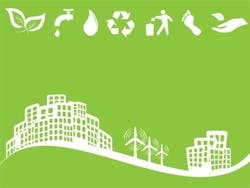5 Things to Know About the New Green Code
Adopting high-performance building strategies is about to get easier. The 2018 International Green Construction Code (IgCC), a model code for sustainable building, integrates the IgCC’s model code provisions with ASHRAE 189.1’s technical requirements to simplify adoption, usage and enforcement.
“The requirements have changed quite a bit, but the concepts are essentially the same,” explains Wes Sullens, director of codes technical development for USGBC. “ASHRAE took over the technical development process and 189.1 has become the guts of the standard. The requirements in terms of stringency have gone up a little bit and there were some new things added, like a focus on resilience. It’s not simply the old IgCC with some updates.”
Download this Green Certification Chart to determine the right certification for your building.
Then, use these 10 tips to make it happen from these industry professionals.
Here are five of the changes you can expect in the new code:
1. Resilience Requirements
The green code already included several measures that contribute to resilience and passive survivability, like energy efficiency and daylighting, Sullens explains. The new one builds on that foundation by adding more advanced resilience strategies, including pre-plumbing that will prepare the building for recycling graywater, using recycled water or rainwater for irrigation, and on-site renewables.
2. Electric Vehicle Infrastructure
The code now reflects the increasing popularity of electric vehicles by including provisions for charging and parking.
“The idea is to start bringing these strategies into building codes. It raises the floor for everybody and makes LEED easier to achieve once we have these systems in place. Do what you can. If you’re in a place that can only adopt three things, start with those three. If you have an energy code in place, look at water and air quality measures to attach to that.” - Wes Sullens
3. Changes to the Water Efficiency Requirements
Previous versions included a prescriptive path and a performance-based path to complying with the water efficiency portion. The performance path has been eliminated, so now the maximum flow limits apply to all water fixtures, Sullens explains.
4. Energy Displays
A new requirement builds on the energy metering and efficiency provisions by adding a display, such as a dashboard or analysis software. “The idea is that you’ll have something that takes measurements, stores that data and then displays it,” Sullens says. “The code describes what it needs to collect and report, but it doesn’t dictate how you present that information.”
[Related: How School District Cut 62 Percent in Energy Spending]
5. Occupant Comfort
An indoor environmental quality survey now appears in chapter 10. It should be implemented within the 6- to 18-month window after the building is occupied. The results are interpreted using a scale from ASHRAE 55 and must be compared to a nationally recognized benchmarking database.
Model codes allow cities to implement parts of the IgCC as it works for them, Sullens explains. Several sections of the IgCC also align with LEED v4 credits, which code developers hope will further accelerate adoption.
“Approach this green code with an incrementalist approach,” Sullens advises. “The idea is to start bringing these strategies into building codes. It raises the floor for everybody and makes LEED easier to achieve once we have these systems in place. Do what you can. If you’re in a place that can only adopt three things, start with those three. If you have an energy code in place, look at water and air quality measures to attach to that.”
Ready to see the rest of the updates? The full text is available from the International Code Council for free.
Two handpicked articles to read next:
About the Author
Janelle Penny
Editor-in-Chief at BUILDINGS
Janelle Penny has been with BUILDINGS since 2010. She is a two-time FOLIO: Eddie award winner who aims to deliver practical, actionable content for building owners and facilities professionals.

